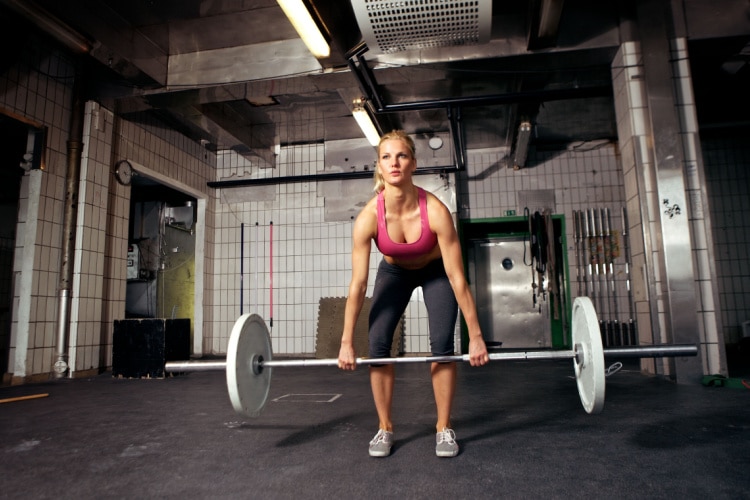Although many trainees think rows, pull downs, and variations thereof are enough for a bigger and stronger back, we feel that the trapezius deserves some love too, as it takes up a lot of real estate and is important to many movements. So, how do you target your traps safely and effectively?
Chances are you’ve heard you need to shrug to build up your traps. While shrugs can be great, this exercise alone probably isn’t enough to get the traps you’re looking for. Rather, we think a trainee should do a combination of trap exercises for a bigger and stronger back.
What are the Best Trap Workouts?
Here are our favorite exercises to train the traps:
- Deadlifts: 3 to 4 sets of 3 to 5 repetitions.
- Pendlay/Barbell Row: 2 to 4 sets of 8 to 12 repetitions.
- Shrugs: 2 to 4 sets of 10 to 15 repetitions.
- Upright Rows: 2 to 4 sets of 10 to 15 repetitions.
- Face Pulls: 2 to 4 sets of 10 to 15 repetitions.
There are a number of exercises that train the traps directly (e.g. shrugs) and indirectly (e.g. deadlifts), each with additional training effects specific to the movement. From a programming perspective, we recommend selecting 1 to 2 priority exercises and 1 to 2 tertiary exercises that train the traps per week. In a body-part split that has a “back” or “pull” day, we’d put all of the exercises selected along with 1 to 2 additional movements. For a full-body training program, we’d spread the selected exercises out evenly.
1. Deadlifts
No move unites lifters, both absolute beginners and bodybuilders, like the deadlift. The deadlift is a hip-oriented movement that works your hamstrings, glutes, core, back, and trapezius muscles. The fact this exercise targets so many muscles at once is what makes its movement pattern — the hinge — fundamental to any training program.
In the deadlift, you lift the weight from the ground to your thighs, primarily with the help of your leg and hip muscles. There are several variations — from the conventional to the sumo and trap bar deadlift, but all of them require your trapezius muscles to work hard to transmit force from the legs through the trunk to the arms. Although it’s mostly isometric in nature (meaning it involves static contraction of the muscle without significant changes in the length of the muscle), you can expect solid growth from this exercise.
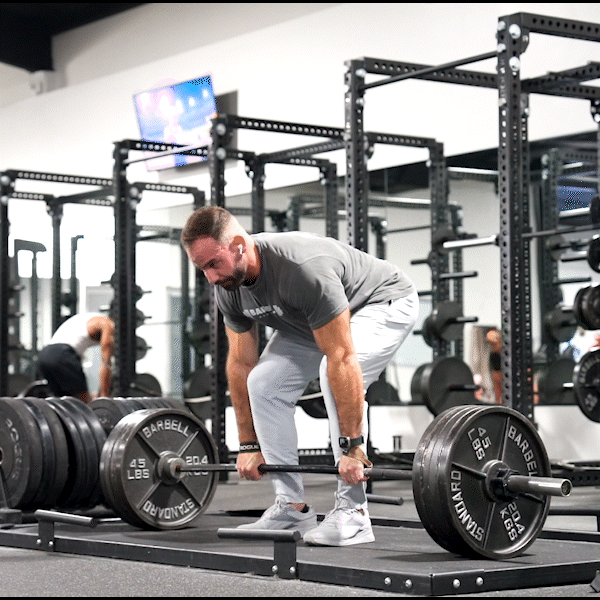
While there is little data on what exercises cause the greatest improvements in hypertrophy of the trapezius, we know that deadlifts load them pretty well, particularly the upper fibers. Research measuring the electrical activity of these areas of the trapezius shows relatively light (12-Rep Max load) sumo and conventional deadlifts get the traps to contract really hard, as measured by a percentage of the muscle’s maximum voluntary isometric contraction (MVIC). [3] Yes, shrugs produce even higher levels of excitation, but the traps are still producing force during the ascent of the deadlift. [4]
Deadlifts can be done in a number of different ways using different stances (sumo vs. conventional), implements (barbell vs. trap bar), ranges of motion (rack pull vs. from the floor), and so on. This time around though, we’ll focus on the conventional deadlift to train for strength and size.
To start, you’ll need a barbell at the appropriate height. A standard 45-pound or 20-kg plate is 450mm in diameter, which spaces the bar ~225mm off the ground. If this is your first time deadlifting, we recommend using a lighter weight but maintaining the appropriate height of the bar using mats under the plate or the safeties in the rack in such a way that the bar is about mid-shin level. Using smaller diameter plates and deadlifting from the ground makes the exercise more difficult due to the added range of motion. While it’s possible to deadlift this way, we recommend learning how to deadlift from the more traditional height.
- Movement category: Primary
- Programming:3 to 4 sets of 3 to 5 repetitions.
- Weight: Use a weight that leaves you 2 to 4 reps short of failure, e.g. RPE 6 to 8
Deadlift Instructions
- Approach the barbell until your shins are about 1” away while standing up straight.
- Take a stance where your feet are about hip-width apart, toes slightly turned outward approximately 5 to 15 degrees.
- Bend over at the waist while keeping your knees mostly straight and grab the barbell with a double overhand grip, placing your hands just outside your legs. Your index finger should be where the smooth center section meets the knurling.
- From here, push your knees forward until your shins touch the barbell, but do not move the barbell with your legs.
- Push your knees out to the sides. They should be touching the inside of your arms at the elbow joint.
- Squeeze your chest up towards the ceiling and look out to a spot on the floor ~ 6 to 10 feet in front of you.
- Take a big breath in and hold it, then drag the bar up your legs, making sure to keep the bar in contact with your legs the entire time.
- Stand up straight at the top, making sure to not lean back.
- Lower the weight back to the starting position.
For a video tutorial on how to deadlift, check out this video. For grip considerations, check out our article on the grip problem.
2. Pendlay/Barbell Row
Strengthening your back and shoulders, the barbell row, or the bent-over row, is a great upper-body weightlifting movement. Named after the late US Olympic weightlifting coach Glenn Pendlay, the Pendlay row is a variation of the standard barbell row where each rep starts and ends on the floor, whereas the more traditional barbell row is done with the bar floating below the knees.
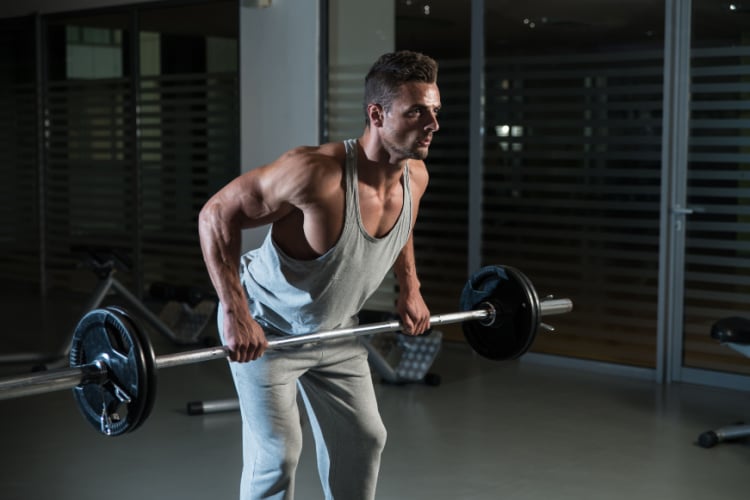
Nearly all types of rows target the same muscles: trapezius, lats, rhomboids, biceps, and rear delts and these two variations are no different. [5] As far as which variation to pick, it’s mostly personal preference with little difference between the two. If forced to choose, the barbell row is a good option if you want to gain muscle, but the Pendlay row is great if you primarily want to get stronger.
- Movement category: Tertiary
- Programming: 2 to 4 sets of 8 to 12 repetitions.
- Weight: Use a weight that leaves you 2 to 3 reps short of failure, e.g. RPE 7 to 8.
Barbell/Pendlay Row Instructions
The main difference between the barbell row and the Pendlay row is the setup position. When doing the barbell row, you start with the bar just under your knees and your torso approximately 45 degrees to the floor. For the Pendlay row, you start from the floor, meaning you must bend further forward to grab the bar. This puts your torso in a slightly more horizontal position than the conventional deadlift or nearly parallel to the floor.
To perform the barbell row:
- Stand with the middle of your foot (about 1” in front of the shins) below the bar. Your feet should be about hip-width apart.
- Grab the barbell with a double-overhand grip about shoulder-width apart. Straps can also be used for this exercise.
- Deadlift the weight up off the floor until it’s just below your knees. Your torso should be at ~ 45* relative to the floor and your arms should be hanging straight down.
- Take a big breath (similar to the deadlift above) and lift the bar towards your sternum using your arms and upper back, aiming to touch your chest at the top.
- Squeeze your shoulder blades together when the bar touches your chest, then lower the weight under control to just below the knees. That’s one rep.
To perform the Pendlay row:
- Stand with the middle of your foot (about 1” in front of the shins) below the bar. Your feet should be about hip-width apart.
- Hinge at the hips and grab the barbell with a double-overhand grip about shoulder-width apart. Straps can also be used for this exercise.
- After squeezing your chest up and taking a big breath (similar to the deadlift above), lift the bar towards your sternum, aiming to touch your chest at the top.
- Squeeze your shoulder blades together when the bar touches your chest, then lower the weight under control. That’s one rep.
As you perform the movement, you want to touch the bar to your sternum and keep the movement relatively strict.
3. Shrugs
The shoulder shrug, or simply the shrug, is an exercise used to develop the upper trapezius muscle. It also targets the shoulders and the upper back. Research suggests that shrugs are effective for training the trapezius muscle as well as other muscles of the neck. [6]
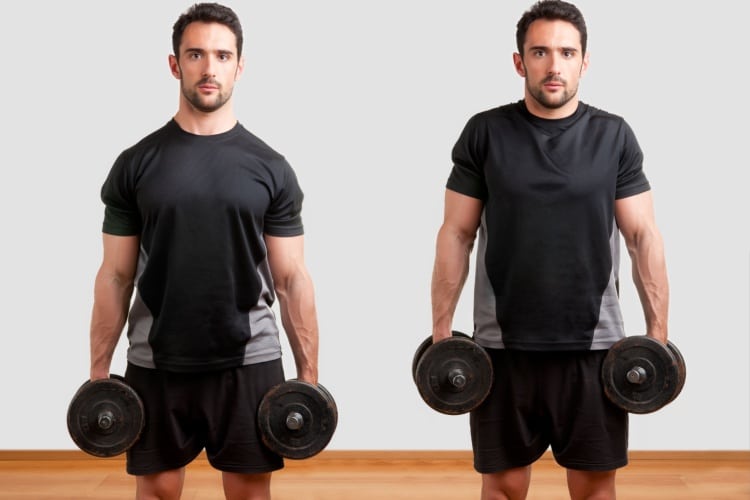
- Movement category: Tertiary
- Programming: 2 to 4 sets of 10 to 15 repetitions.
- Weight: Use a weight that leaves you 1 to 2 reps short of failure, e.g. RPE 8 to 9.
To do the shrug, you need a barbell, dumbbell, trap bar, kettlebells, or a Smith machine. The instructions are roughly the same, but we’ll focus on how to do a shrug with dumbbells below:
Shrugs Instructions
- Grab a pair of dumbbells and stand up straight with a hip-width stance.
- Keeping your hands at your sides gripping the dumbbells with elbows fully extended and palms facing the body. This is your starting position.
- Lift the dumbbells up while keeping your elbows straight, aiming to touch your shoulders to your ears. Aim to keep your head and neck still.
- Slowly lower the dumbbells under control while keeping your elbows extended. That’s one rep.
Barbell, trap bars, and dumbbell shrugs are likely to be equally effective here. We’d urge you to aim for a controlled tempo and full range of motion. Again, you may use straps so that grip fatigue doesn’t pose an issue.
4. Upright Rows
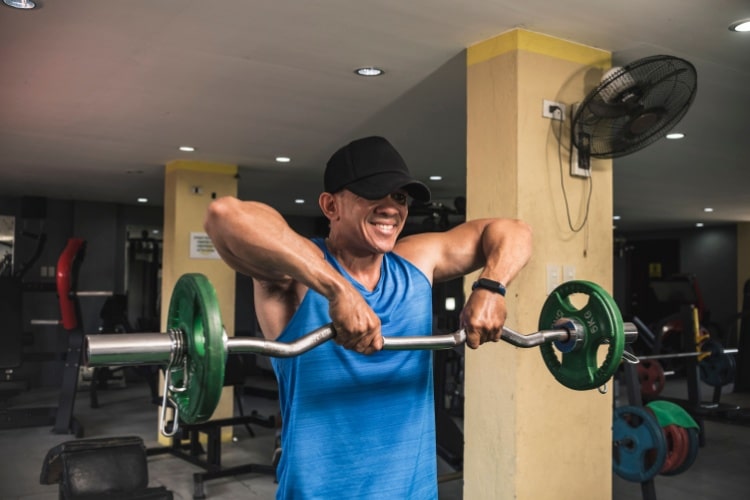
An upright row is an effective exercise to build strength in the shoulders and upper back. While popular with many lifters, some health professionals have suggested that performing the exercise in a traditional manner may increase the risk of shoulder “impingement.” [8]
Shoulder impingement is a term that historically referred to the rotator cuff and/or subacromial bursa being irritated in the subacromial space, e.g. between the acromion of the scapula and the head of the humerus. [7] However, shoulder impingement is now recognized to be a spectrum of clinical findings involving shoulder pain and dysfunction, not injury to a specific structure. If you have shoulder pain already, consider getting in touch with us. Our coaching team includes physicians and rehab specialists who can help you get back on track as soon as possible.
In any case, upright rows do not appear to be uniquely injurious to the shoulders in practice. As with other exercises, we recommend starting conservatively with load and volume and progressively loading yourself over time.
- Movement category: tertiary
- Programming: 2 to 4 sets of 10 to 15 repetitions.
- Weight: Use a weight that leaves you 2 to 3 reps short of failure, e.g. RPE 7 to 8.
Upright Row Instructions
- Stand with your feet about shoulder-width apart. Pick up the barbell with a double overhand grip with a narrow grip at the center of the barbell and extended elbows.
- Take a deep breath, and brace your core, keeping your chest up and your eyes looking forward.
- Lift the barbell upwards towards your chin with your elbows high and out to the side. Keep the bar close to the body during the movement. The top of the rep is right at about the level of your collarbone.
- From here, lower the weight slowly and control until your elbows are extended and you’re back at the start position. That’s one rep.
Barbell and dumbbell upright rows are likely to be equally effective here. You may use straps so that grip fatigue doesn’t pose an issue.
5. Face Pulls
The face pull is a machine-based exercise mainly done to isolate the posterior muscles of the shoulder girdle with the arms in external rotation. They’re good for your rear delts, trapezius, and upper back muscles including the rotator cuff, since they help to stabilize your shoulder joint during movement. [9]
Fatigue-wise, face pulls use fairly light weights to train small amounts of muscle mass over a small range of motion, thereby likely reducing the amount of training fatigue generated. Equipment-wise, you need a cable pulley machine to do face pulls.
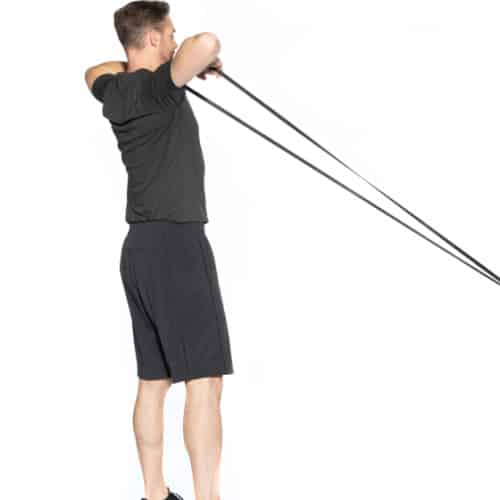
- Movement category: tertiary
- Programming: 2 to 4 sets of 10 to 15 repetitions.
- Weight: Use a weight that leaves you 2 to 3 reps short of failure, e.g. RPE 7 to 8.
Face Pull Instructions:
- Adjust the cable pulley machine so that the pulley system is positioned just above your head. Use the rope attachment with two hand-holds to do the exercise.
- Grab the handles with your hands and your palms facing in. Take a step back until both arms are completely stretched out, then engage your core and lean back a bit (your body should be positioned at an approximately 20-degree angle).
- Pull the rope toward you as much as necessary to begin lifting the weight from the stack. Engage both shoulders — roll them back to ensure proper posture (avoid having them hunched or rolled forward). This is the beginning position.
- Pull the handles toward your forehead.
- Flare your elbows outward to the sides of your body, thus, engaging your rear delts.
- Reverse the movement and gradually stretch both arms without letting your chest or shoulders roll forward as you stretch.
Make sure to focus on using a controlled tempo and on the squeeze at the end of the range of motion.
Trap Muscles Anatomy
The trapezius muscle is a large back muscle resembling a trapezoid, hence its name. Its function is to move the scapula and support the arm. The muscle emerges from the back of the skull at both the superior nuchal line and the occipital protuberance along with the spinous processes of C7 to T12 vertebrae and runs the clavicle (collarbone), acromion (front of shoulder), and spine of the scapula. [1]
It is made up of long muscle fibers with upper, middle, and lower sections. The upper fibers elevate and rotate the scapula upward, the middle group retracts the scapula, and the lower fibers depress and assist the upper fibers in rotating the scapula upward. [2]
Overall, the trapezius is a big muscle that is involved in posture along with stability and movement of both the neck and scapula.
What are the Benefits of Exercising Your Traps?
Exercising your traps comes with a plethora of benefits. Let’s take a look at the most significant ways you can profit from effective trap exercises and outline some of the benefits of strength training in general.
Reduced Back & Neck Pain
Exercise regimens that incorporate deadlifts may help with lower back pain (LBP) and function. Having said that, they haven’t been proven to be any more helpful than other types of exercise. [10]
Strength exercises in women with chronic neck muscle pain have proven to be effective. Furthermore, research suggests that the highest level of trapezius activation was found during the shrug, lateral raise, and upright row exercises. [11]
Stronger Bones
As people age, resistance training and doing exercises such as deadlifts become essential to maintaining good bone health. [12] To strengthen your bones, you need to place weight on them. Fortunately, movements like deadlifts and other types of weight-bearing exercises allow you to load your spine and hips — two common areas of osteoporosis — with a considerable amount of weight. When we lift weights, the cells known as osteoblasts get stimulated to start producing the “bony matrix”, which later gets calcified as bone.
Research also suggests that long-term lifting with squats and deadlifts brings about an increase in bone density in younger individuals, and assists with maintaining that increase later on in life. [15,16,17]
Resistance training also helps with osteoarthritis, a common disabling disease linked to joint pain. Most of the time, it affects the hips, knees, and hands of middle-aged people and the elderly. Training produces positive changes in muscle strength, functional ability, and pain scores, even in people dealing with more advanced stages of the disease. [13] What’s more, if you begin lifting earlier, not only can you lower the loss of strength connected to osteoarthritis, but you can also slow or stop its progress. [14]
Disease Prevention
Having a consistent strength training routine is linked to a decreased risk of a wide range of diseases, including cardiovascular illnesses, cancer, and type II diabetes. [32] What’s more, it seems that people who become stronger through training see improvements in health as opposed to those who train but don’t become as strong. [18,19]
Training in a manner that increases muscle strength and size decreases resting blood pressure and blood cholesterol levels, leading to a reduced risk of cardiovascular issues. Strength training may improve cardiorespiratory fitness in people with lower levels of aerobic capacity and enhance performance in endurance-based sports. [20,21]
Mental Health Benefits
It has been demonstrated that strength training enhances mental health by lowering stress and anxiety. [22] It has been shown that regular resistance exercise lowers the incidence or signs of a number of mental health conditions, like anxiety and depression. These impacts appear to take place through an unidentified mechanism, even if the individuals don’t end up getting stronger. [23]
Finally, lifting weights has also been shown to enhance sleep quality, which is a major benefit because adequate sleep is essential for maintaining mental well-being. [24]
Weight Management
Lifting weights has been shown to minimize waist circumference by decreasing abdominal fat. [25] Additionally, exercise training can make some people feel fuller when they eat, which may aid in weight loss or maintenance. [26]
The extra energy required for post-workout recovery processes like muscle remodeling and repair is known as excess post-exercise oxygen consumption (EPOC). Increasing EPOC is a technique frequently used to reduce belly fat or abdominal adipose tissue. [27] Note that research suggests that increases in muscle protein synthesis rates in the post-exercising period may indicate a notable increase in resting energy expenditure. [28]
On the whole, when resistance training increases in volume, intensity, and amount of muscle mass employed, so does the energy expenditure during EPOC. As many metabolic processes are adapted to make trained persons more efficient, EPOC is thus higher in untrained than in trained individuals. [29] It’s not clear whether EPOC raises the total amount of calories per day, that is, the total daily energy expenditure (TDEE). Current research suggests that the overall energy contribution of EPOC to TDEE is minimal, but this area needs more study. [30]
It’s also worth noting that the increase in muscle mass increases resting metabolic rate. It might seem that a person’s total daily energy expenditure would increase with an increase in resting metabolic rate; however, this is probably false.
One kg of muscle uses around 13 calories on a daily basis. On the other hand, 1 kg of fat uses 4.5 calories daily. [31] To make a noticeable difference in your total daily energy expenditure, you’d need to gain a lot of muscle mass. Gaining 10 kg of muscle mass usually takes years and could potentially boost your total daily energy expenditure by less than 100 calories on a daily basis.
In any case, the mechanisms connected to the science of lifting weights are much more complicated than this. These mechanisms entail changes at the muscle level, endocrine system, the brain, and so on, leading to an enhanced body composition for trainees who lift weights consistently.
Common Questions
Are traps easy to grow?
They’re probably about as easy to grow as any other muscle that can be trained. While they seem to respond well to loading, it’s not clear if they’re easier or harder to grow compared to another muscle or muscle group. Nevertheless, they need to be trained in order to be developed.
How can I build my trap muscles fast?
It’s hard to say, as there’s little in the way of research regarding how quickly traps grow in response to a particular training program. Even if there was, it’s unlikely that two individuals will respond the same. Rather, each will gain strength, size, and fitness at their own pace based on their current fitness, genetics, nutrition, training, and so on. Still, the traps seem to respond well to training, like most other muscles.
Can you strengthen traps without deadlifts?
Yes, absolutely! Nearly any exercise that loads the traps in a way that causes them to produce force will improve their strength on some level. It all depends on how you’re testing someone’s strength, right? Still, we think that the deadlift or some sort of loaded hinge movement pattern should be included in most folks’ training regardless of their effects on the traps. They’re still a great exercise overall.
Summary
To sum up, the best trap exercises for a bigger and stronger back are the following:
- Deadlifts
- Pendlay/Barbell Row
- Shrugs
- Upright Rows
- Face Pulls
If you’re looking for a more intensive workout program, however, have a look at some of our training templates. Here at Barbell Medicine, we always keep up with the latest fitness trends and sports developments and adjust our programs in line with the latest research and the most effective techniques. In case a pre-made program isn’t your thing and you’d like a more personal touch, opt for a custom-made program instead.
Like what we offer but aren’t sure you can commit right away? We invite you to join our email list and get free access to our introductory training programs before making up your mind.
References
1. Ourieff, J., Scheckel, B., & Agarwal, A. (2021). Anatomy, Back, Trapezius. PubMed; StatPearls Publishing. https://www.ncbi.nlm.nih.gov/books/NBK518994/#:~:text=The%20trapezius%20muscle%20is%20a
2. Henderson, Z. J., Bohunicky, S., Rochon, J. A., Dacanay, M., & Scribbans, T. D. (2021). Muscle activation in specific regions of the trapezius during modified Kendall manual muscle tests. Journal of Athletic Training. https://doi.org/10.4085/545-20
3. Escamilla, Rafael F et al. “An electromyographic analysis of sumo and conventional style deadlifts.” Medicine and science in sports and exercise vol. 34,4 (2002): 682-8. doi:10.1097/00005768-200204000-00019
4. Ekstrom, Richard A, et al. “Surface electromyographic analysis of exercises for the trapezius and serratus anterior muscles.” The Journal of Orthopaedic and Sports Physical Therapy vol. 33,5 (2003): 247-58. doi:10.2519/jospt.2003.33.5.247
5. Fenwick, C. M. J., Brown, S. H. M., & McGill, S. M. (2009). Comparison of Different Rowing Exercises: Trunk Muscle Activation and Lumbar Spine Motion, Load, and Stiffness. Journal of Strength and Conditioning Research, 23(2), 350–358. https://doi.org/10.1519/jsc.0b013e3181942019
6. Gao, Kristensen, Grøndberg, Murray, Sjøgaard, & Søgaard. (2020). Electromyographic Evaluation of Specific Elastic Band Exercises Targeting Neck and Shoulder Muscle Activation. Applied Sciences, 10(3), 756. https://doi.org/10.3390/app10030756
7. Consigliere, Paolo et al. “Subacromial impingement syndrome: management challenges.” Orthopedic research and reviews vol. 10 83-91. 23 Oct. 2018, doi:10.2147/ORR.S157864
8. Schoenfeld, B., Kolber, M. J., & Haimes, J. E. (2011). The Upright Row: Implications for Preventing Subacromial Impingement. Strength & Conditioning Journal, 33(5), 25–28. https://doi.org/10.1519/ssc.0b013e31822ec3e3
9. Sakoma, Y., Sano, H., Shinozaki, N., Itoigawa, Y., Yamamoto, N., Ozaki, T., & Itoi, E. (2010). Anatomical and functional segments of the deltoid muscle. Journal of Anatomy, 218(2), 185–190. https://doi.org/10.1111/j.1469-7580.2010.01325.x
10. Fischer, S. C., Calley, D. Q., & Hollman, J. H. (2021). Effect of an Exercise Program That Includes Deadlifts on Low Back Pain. Journal of Sport Rehabilitation, 30(4), 672–675. https://doi.org/10.1123/jsr.2020-0324
11. Andersen, L. L., Kjær, M., Andersen, C. H., Hansen, P. B., Zebis, M. K., Hansen, K., & Sjøgaard, G. (2008). Muscle Activation During Selected Strength Exercises in Women With Chronic Neck Muscle Pain. Physical Therapy, 88(6), 703–711. https://doi.org/10.2522/ptj.20070304
12. Hong, A. R., & Kim, S. W. (2018). Effects of Resistance Exercise on Bone Health. Endocrinology and Metabolism, 33(4), 435. https://doi.org/10.3803/enm.2018.33.4.435
13. Turner MN, Hernandez DO, Cade W, Emerson CP, Reynolds JM, Best TM. The Role of Resistance Training Dosing on Pain and Physical Function in Individuals With Knee Osteoarthritis: A Systematic Review. Sports Health. 2020 Mar/Apr;12(2):200-206. doi: 10.1177/1941738119887183. Epub 2019 Dec 18. PMID: 31850826; PMCID: PMC7040944.
14. Kristensen J, Franklyn-Miller A. Resistance training in musculoskeletal rehabilitation: a systematic review. Br J Sports Med. 2012 Aug;46(10):719-26. doi: 10.1136/bjsm.2010.079376. Epub 2011 Jul 26. PMID: 21791457.
15. Almstedt, H. C., Canepa, J. A., Ramirez, D. A., & Shoepe, T. C. (2011). Changes in Bone Mineral Density in Response to 24 Weeks of Resistance Training in College-Age Men and Women. Journal of Strength and Conditioning Research, 25(4), 1098–1103. https://doi.org/10.1519/jsc.0b013e3181d09e9d
16. Lloyd, R. S., Cronin, J. B., Faigenbaum, A. D., Haff, G. G., Howard, R., Kraemer, W. J., Micheli, L. J., Myer, G. D., & Oliver, J. L. (2016). National Strength and Conditioning Association Position Statement on Long-Term Athletic Development. Journal of Strength and Conditioning Research, 30(6), 1491–1509. https://doi.org/10.1519/jsc.0000000000001387
17. Walters, P. H., Jezequel, J. J., & Grove, M. B. (2012). Case Study: Bone Mineral Density of Two Elite Senior Female Powerlifters. Journal of Strength and Conditioning Research, 26(3), 867–872. https://doi.org/10.1519/jsc.0b013e31822c71c0
18. Igarashi, Yutaka. Effects of Differences in Exercise Programs With Regular Resistance Training on Resting Blood Pressure in Hypertensive Adults: A Systematic Review and Meta-Analysis. Journal of Strength and Conditioning Research 37(1):p 253-263, January 2023. | DOI: 10.1519/JSC.0000000000004236
19. Jansson AK, Chan LX, Lubans DR, Duncan MJ, Plotnikoff RC. Effect of resistance training on HbA1c in adults with type 2 diabetes mellitus and the moderating effect of changes in muscular strength: a systematic review and meta-analysis. BMJ Open Diabetes Res Care. 2022 Mar;10(2):e002595. doi: 10.1136/bmjdrc-2021-002595. PMID: 35273011; PMCID: PMC8915309.
20. Balabinis CP, Psarakis CH, Moukas M, Vassiliou MP, Behrakis PK. Early phase changes by concurrent endurance and strength training. J Strength Cond Res. 2003 May;17(2):393-401. doi: 10.1519/1533-4287(2003)017<0393:epcbce>2.0.co;2. PMID: 12741884.
21. Ozaki, H., Loenneke, J.P., Thiebaud, R.S. et al. Resistance training induced increase in VO2max in young and older subjects. Eur Rev Aging Phys Act 10, 107–116 (2013). https://doi.org/10.1007/s11556-013-0120-1
22. Barahona-Fuentes, G., Huerta Ojeda, Á., & Chirosa-Ríos, L. (2021). Effects of Training with Different Modes of Strength Intervention on Psychosocial Disorders in Adolescents: A Systematic Review and Meta-Analysis. International Journal of Environmental Research and Public Health, 18(18), 9477. https://doi.org/10.3390/ijerph18189477
23. Gordon BR, McDowell CP, Hallgren M, Meyer JD, Lyons M, Herring MP. Association of Efficacy of Resistance Exercise Training With Depressive Symptoms: Meta-analysis and Meta-regression Analysis of Randomized Clinical Trials. JAMA Psychiatry. 2018 Jun 1;75(6):566-576. doi: 10.1001/jamapsychiatry.2018.0572. PMID: 29800984; PMCID: PMC6137526.
24. Kovacevic A, Mavros Y, Heisz JJ, Fiatarone Singh MA. The effect of resistance exercise on sleep: A systematic review of randomized controlled trials. Sleep Med Rev. 2018 Jun;39:52-68. doi: 10.1016/j.smrv.2017.07.002. Epub 2017 Jul 19. PMID: 28919335.
25. O’Donoghue, G, Blake, C, Cunningham, C, Lennon, O, Perrotta, C. What exercise prescription is optimal to improve body composition and cardiorespiratory fitness in adults living with obesity? A network meta-analysis. Obesity Reviews. 2021; 22:e13137. https://doi.org/10.1111/obr.13137
26. Hopkins, Marka,b; King, Neil Ac; Blundell, John Ea. Acute and long-term effects of exercise on appetite control: is there any benefit for weight control? Current Opinion in Clinical Nutrition and Metabolic Care 13(6):p 635-640, November 2010. | DOI: 10.1097/MCO.0b013e32833e343b
27. Bahr, R. “Excess postexercise oxygen consumption–magnitude, mechanisms and practical implications.” Acta Physiologica Scandinavica. Supplementum vol. 605 (1992): 1-70.
28. Welle, S, and K S Nair. “Relationship of resting metabolic rate to body composition and protein turnover.” The American Journal of Physiology vol. 258,6 Pt 1 (1990): E990-8. doi:10.1152/ajpendo.1990.258.6.E990
29. Abboud, George J et al. “Effects of load-volume on EPOC after acute bouts of resistance training in resistance-trained men.” Journal of Strength and Conditioning Research vol. 27,7 (2013): 1936-41. doi:10.1519/JSC.0b013e3182772eed
30. LaForgia, J et al. “Effects of exercise intensity and duration on the excess post-exercise oxygen consumption.” Journal of sports sciences vol. 24,12 (2006): 1247-64. doi:10.1080/02640410600552064
31. Wang, Zimian, et al. “Evaluation of specific metabolic rates of major organs and tissues: comparison between men and women.” American Journal of Human Biology: the official journal of the Human Biology Council vol. 23,3 (2011): 333-8. doi:10.1002/ajhb.21137
32. Sullivan, J., Feigenbaum, J., & Baraki, A. (2023). Strength training for health in adults: Terminology, principles, benefits, and risks. In: UpToDate. Grayzel J (Ed). Available from https://www.uptodate.com/contents/strength-training-for-health-in-adults-terminology-principles-benefits-and-risks
